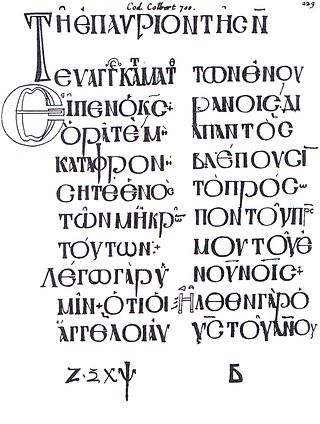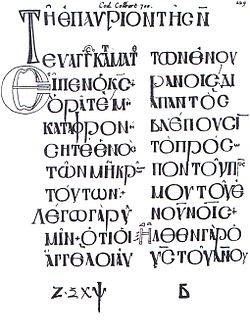Top Qs
Timeline
Chat
Perspective
Lectionary 1
New Testament manuscript From Wikipedia, the free encyclopedia
Remove ads
Lectionary 1, designated siglum ℓ 1 (in the Gregory-Aland numbering), is a Greek manuscript of the New Testament on vellum. Palaeographically it has been assigned to the 10th century.[1] Formerly it was known as Codex Colbertinus 700, then Codex Regius 278.
Remove ads
Description
The codex contains lessons from the Gospels lectionary (Evangelistarium) with some lacunae.[2] The text is written in Greek uncial letters, on 265 parchment leaves (30 cm by 24 cm), 2 columns per page, 10 lines per page,[1] 7–9 letters per line.[2]
Lessons from the codex were read from Pascha to Pentecost.[1]
History
Formerly it was variously dated. Scrivener dated to the 8th century,[3] Henri Omont to the 14th century, Gregory to the 10th century. In the present day it is unanimously dated to the 10th century.[4]
The manuscript once belonged to Colbert.[3] It was examined and described by Bernard de Montfaucon,[5] Wettstein,[6] Scholz,[2] Paulin Martin,[7] and Henri Omont.[8] C. R. Gregory saw the manuscript in 1885.[2]
It was added to the list of the New Testament manuscripts by Wettstein.[9]
The manuscript is sporadically cited in the critical editions of the Greek New Testament of UBS (UBS3).[10] It is not cited in UBS4.[11]
The codex now is located in the Bibliothèque nationale de France (Gr. 278).[1][4]
Remove ads
See also
Notes and references
Bibliography
Wikiwand - on
Seamless Wikipedia browsing. On steroids.
Remove ads

